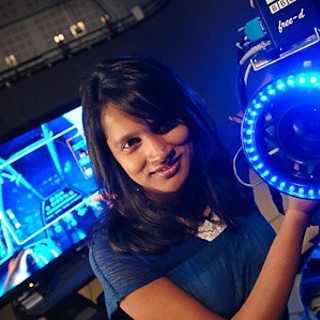At the Â鶹ԼÅÄ R&D, we have been working on how to exploit the interactive functionality now available through connected televisions through a number of projects under themes such as companion screens, authentication, Internet of Things, recommendation services, accessibility and so on. They are all exciting topics to explore and we were interested in finding out what the research community had to say on the subject. To this effect, on Saturday 27th April, at the Universite Paris Dauphine, we co-chaired a day-long workshop called ‘Exploring and Enhancing the User Experience for Television’ (TVUX), with our colleague Dr Jhilmil Jain, from Google.

The workshop formed part of the annual . Usually referred to by its short name CHI (pronounced ‘kai’), this is the world’s biggest and most prestigious research conference in the science and engineering of human-computer interaction, and has grown over the last 31 years to attract well over 3000 academic and industrial participants annually. Over the last couple of CHIs, we’ve sought to harness the brains of this community and promote the user experience of television as an important and exciting area for research. At CHI2012, we won an award for our Case Study paper, ‘’. More importantly, we were able to engage in many interesting conversations about our work and got encouraging positive feedback.
This year, bolstered by the outcomes from last year, we set out to be more ambitious, and our was accepted by CHI. That gave us scope to curate our own collaborative event, as part of the CHI2013 programme. We published a , from industry and academia, on five key themes in TV user experience research, and hoped to attract enough people to have a lively discussion. The response from the research community was overwhelming. With the support of the CHI workshop chairs, we increased the size of the workshop, and our wonderful programme committee painstakingly reviewed the 41 submissions we received to form an amazing programme of 24 papers.
Our programme had contributions from Google, Hewlett-Packard, Yahoo and Cisco, as well as work from our own colleagues at Â鶹ԼÅÄ R&D.
University researchers from the US, the UK, Canada, Belgium, Sweden, Germany, Singapore and Spain had their papers accepted, and we had work from national research labs - INRIA in France and NICTA in Australia - as well as from small UX agencies. It was a fantastic mix! 22 of our 24 accepted authors were able to join us in person in Paris for the workshop! One of the authors even brought along a Google glass which made for interesting breaks in between all the hard work.
At the workshop, having a great discussion about the issues and potential of the research work presented was the main priority. We used a symposium style, with five sessions of very short presentations by the participating authors on their work, each followed by a whole group discussion led by the session chair. Each of the five discussions concluded with participants’ visions of the future of research and user experience for these aspects of TV interaction.
Control and Physical Interaction
Discussions and presentations during the control and physical interaction session focused on how to couple new interfaces with a TV. Gestural interfaces have been rising in popularity and there were concerns that suitable feedback metaphors should be researched in order to better represent corresponding actions. It was stressed that this was even more important for audience members with special needs. There was also discussions about what types of gestures would be suited to a living room environment. Participants felt that there would still be a place for traditional remote controls and that companion devices would be more integrated into the living room. There was support for open APIs which could be personalised and it was felt that some TV experiences would move from a lean back one to a lean forward one in keeping with new forms of video content such as the ultra high resolution video panorama produced in the project.
User Response
Amongst other things, the panel on user responses discussed how traditional TV interaction could be more affective by using eye-trackers and physiological sensors to gauge audience behaviour in order to cross-validate the emotional characteristics of content. Main concerns included figuring out how intrusive the collection process is. The gaming area was seen as a source of inspiration, however, the users of gaming systems are active it is easier to ascertain their emotions and distill the range of emotions experienced during the games. In the world of TV, the users tend to be passive and the emotions (and in turn the physiological responses) are toned down.
Personalisation and Recommendation
Discussions on Personalisation and Recommendation uncovered hypotheses relating the complex interaction between choice, schedules and adaptation, including for shared viewing within families. Along with reasons for presentation of a recommendation, systems that encourage exploration were preferred. Physiological sensors and emotional deductions were seen as preferred tools to better ascertain audience preferences which could then be used to inform recommendation algorithms. The participants felt that big data and stronger links to the social web would also inform future recommendation algorithms.
Distributed User Interface and Connected Devices
When it came to Distributed UI and Connected Devices, the panel felt that mobile devices would play a big part in enabling connected experiences. Topics varied from differences between audience demographics and what they expected from the TV experience to how various devices could be connected seamlessly to the connected TV in order to enable connected experiences. The panel felt that differentiation of devices in the home will become more abstract and usage across devices wouldn’t matter especially with the addition of pervasive computing devices in our living rooms.
Analytical and Experimental work
The final panel session centered around discussing how to balance qualitative and quantitative data gathering in conjunction with lab-based or ethnographic based experimentation. The assembled participants questioned the differences between UX testing on the web and TV. How does UX testing change when companion devices are involved?
In the weeks to come we will be publishing the proceedings of the workshop, as a resource for the researchcommunity and a citable academic record of the excellent work our participants produced. We would like to take this opportunity to thank and for taking wonderful notes through the workshop. Notes that we will be referring to in order to capture the spirit of the workshop. We’ll also be deciding where next to take our involvement in the HCI research community and CHI in particular. We have taken an important couple of first steps in positioning the user experience of television - and in particular, of internet-connected television - as a distinctive research area, with enormous potential to impact millions of users. In the mean time, the position papers can be accessed at the .
Our workshop ended with participants’ discussing how to continue to build this research momentum, and what other topics in TV UX could be important. This list included best practice in research methodology, international cultural differences, the divide between industry led and academic led research, the effects of 3D TV, multimodal interface, serious games, ethnographic studies around commercial ground truth, standardisation and data collection tools. The Â鶹ԼÅÄ’s viewers stand to benefit immeasurably, from the work of some of the best scientists in the world, as they seek discover more about how to make best use of the amazing resource of a large, shared screen in millions of living rooms.

